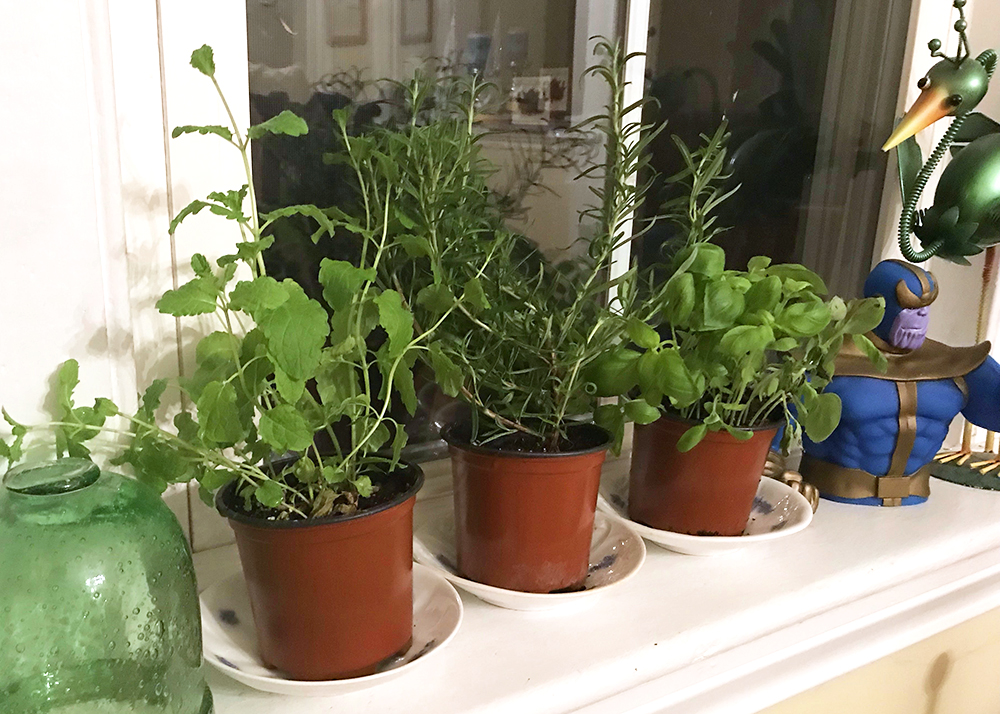How to start an indoor herb garden

Fresh herbs can transform an everyday dinner into a special occasion, but herbs at the grocery store can be expensive and difficult to keep fresh. Starting an indoor herb garden is a relatively simple and compact project that will give you daily access to fresh herbs.
Growing an indoor herb garden
Though you can grow an indoor herb garden in an especially sunny living or dining room, your kitchen is the best place if you want easy access to your fresh herbs for cooking. If your space is kept between 60 and 70 degrees, you can grow herbs indoors all year round, as long as they have enough light — to thrive indoors, herbs need as much natural light as possible.
“When I’m working with people in the city, the number one thing is getting the light requirements right,” says Sera Rogue, owner and designer of Red Fern, a company that consults on and designs interior green spaces in Brooklyn, NY. Six hours of sunlight a day is ideal.
In general, herbs will thrive on your windowsill. Even though the temperature drops slightly at night, most herbs enjoy the evening chill. Just keep foliage from touching the glass; otherwise, your tasty leaves will blacken in the cold. If your windowsill is too small to hold a pot, place your plants in a spot where the sun shines for most of the day.
If you’re stuck with north-facing windows — or perhaps you have no windows at all in your kitchen — you can still have the herb garden of your dreams with the help of some full-spectrum grow lights, which mimic the rays of the sun either by filtering it through a special glass for incandescent lights, using a chemical mix for fluorescent lights, or by balancing the right ratio of light output from different colored diodes for LED lights. You can purchase them at most garden supply stores or on Amazon.com. The lights should stay on for between 10 and 16 hours during the day and be turned off at night.
When watering, focus on the roots; that’s where the plant is drinking from. Misters are unnecessary, and getting the leaves wet might not be the best idea because it could attract pests or mold. Rogue recommends watering every day in the heat of the summer (when it’s a little bit cooler, every other day will do), but how often you water your herbs depends on the micro-climate of your apartment.
“Some people’s homes are drier, and some people’s are a little hotter,” Rogue says. “What you want to do is get in a habit of checking your plants every day. Observe how long it takes your plant to dry out and make a watering schedule.”
Herbs have a very simplistic root system, though, so you also do not water to overwater the plants and drown their roots. Overwatered herbs will yellow in its leaves, attract flies or gnats, and develop moldiness in the soil. To avoid overwatering, stick your fingers beneath the soil; if you feel moisture, you can skip watering that day.
Can you grow herbs in a mason jar?
Choosing the right container for your herbs is the best way to ensure proper drainage. Apologies to hipster aesthetes: mason jars are a no-go.
“Mason jars aren’t very good for drainage, obviously, because there’s no hole,” Rogue says. “You have to be an expert waterer if you’re planting something without a drainage hole.”
Get a pot with a drainage hole and put them on a tray to prevent damage to the surface (it would be shame to rot your windowsill). Ceramic and plastic pots are best because terracotta is leaky, but if that is your material of choice, make sure the tray is on a cork coaster. Also, make sure you use potting soil as opposed to garden soil, as it will have chemicals in it like perlite that promote drainage.
What herbs you should grow
Some herbs are hardier than others. Oregano, thyme, chives, parsley, and mint (an especially voracious herb) are pretty forgiving to the sun and watering foibles of first-time herb gardeners. “Basil is definitely the diva of the group, but it’s the one that everyone wants,” says Rogue.
Because basil demands consistent warmth, so it should not be grown near drafty windows. Rosemary is a little more hardy, but it can also finicky about steady light and temperatures.
If you want to plant herbs from seeds, you should start around March. The days are longer and your seedlings will benefit from more hours of sun; by the time May rolls around, you will have a pretty good sized plant. There is a litany of independent seed companies you can purchase herbs from in addition to the classics like Burpee. If winter is coming and you can’t wait to get started, it might be easier to grab small plants from your local supermarket.
Ultimately, the herbs you grow in your indoor herb garden should be the herbs you use. If you plan around your favorite dishes, your endeavors will quickly become the greatest asset to your culinary routine.
